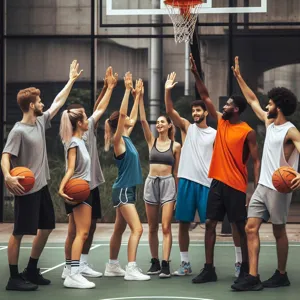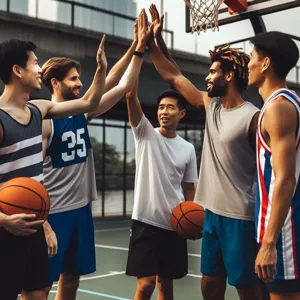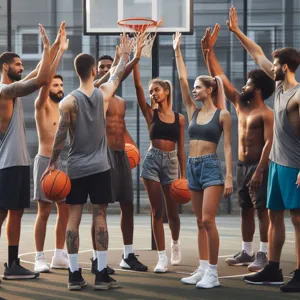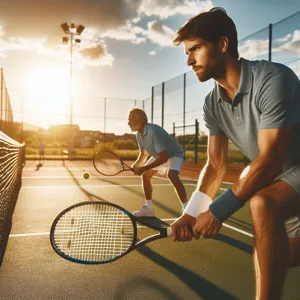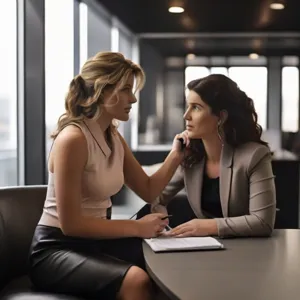In the fast-paced world of basketball, success on the court hinges not only on individual talent but also on the seamless collaboration of the entire team.
As the game evolves, so too does the understanding of what it takes to foster exceptional teamwork. Whether you’re a coach looking to elevate your players’ synergy or a player eager to contribute more effectively, mastering the art of teamwork can unlock your team’s potential and lead to victories. In this blog post, we’ll delve into five key strategies that can enhance communication, build trust, and cultivate a culture of collaboration within your basketball team. Get ready to discover how these essential tactics can transform your squad into a cohesive unit that plays with purpose and passion, ultimately setting the stage for success on and off the court.
1. Introduction to Teamwork in Basketball

Basketball is more than just a game of individual talent; it is a dynamic dance of teamwork and collaboration. The essence of basketball lies in its fast-paced nature, requiring players to fluidly navigate the court, anticipate each other’s movements, and execute plays that rely on collective effort. A well-coordinated team can elevate a group of talented individuals into a formidable force, capable of overcoming even the toughest opponents.
In this section, we will explore the significance of teamwork in basketball and how it manifests on and off the court. From the synergy between players during intense game situations to the camaraderie built during countless practice sessions, teamwork is the cornerstone of a successful basketball team. It fosters communication, builds trust, and encourages players to play for something greater than themselves.
Moreover, understanding the principles of teamwork can transform not only how a team performs but also how individual players develop their skills. When players learn to work together, they enhance their strategic thinking, improve their defensive and offensive coordination, and create a cohesive unit that thrives under pressure.
As we delve deeper into the strategies that can enhance teamwork in basketball, we will uncover how fostering a strong team culture, encouraging open communication, and cultivating mutual respect can unlock the full potential of your team. Get ready to discover the keys to not just playing better basketball, but becoming a true team in every sense of the word.
2. Understanding the Importance of Team Chemistry
Understanding the importance of team chemistry is pivotal to unlocking the full potential of any basketball squad. Team chemistry goes beyond just having skilled players on the roster; it’s about fostering a deep connection among teammates that translates into seamless collaboration on the court. When players genuinely understand and trust one another, they instinctively know where their teammates will be, anticipate their moves, and communicate effectively during high-pressure situations.
This chemistry is often developed through shared experiences, both on and off the court. Team-building activities, whether they involve trust exercises, social outings, or community service, help to break down barriers and build relationships. These moments create a sense of belonging and mutual respect, which in turn enhances communication and cooperation during games.
Moreover, players who have a solid rapport are more likely to support one another emotionally, celebrating successes and navigating challenges together. This emotional bond can be the difference between a team that merely functions and one that thrives, especially when facing formidable opponents.
Coaches play a crucial role in fostering this chemistry by promoting an inclusive environment that encourages open dialogue and collaboration. By emphasizing the idea that each player has a unique role—regardless of their skill level—coaches can help cultivate a culture of respect and teamwork.
In essence, when players invest in building positive relationships with one another, they create a cohesive unit that works harmoniously toward a common goal. This synergy not only enhances individual performance but elevates the entire team’s efficacy, making understanding and nurturing team chemistry a foundational pillar for success in basketball.
3. Strategy 1: Establish Clear Roles and Responsibilities

In any successful basketball team, the foundation of effective teamwork lies in establishing clear roles and responsibilities. This means that every player should understand their unique position on the court, how their skills complement their teammates, and the specific contributions expected of them during both practice and games.
To achieve this, begin with open discussions among players and coaching staff. Facilitate conversations that allow each team member to express their strengths, preferences, and areas for growth. For example, while some players may excel in shooting and scoring, others might thrive in defensive roles or playmaking. By identifying these strengths, you can assign roles that not only enhance individual performance but also foster a cohesive unit.
Moreover, it’s vital to set specific, measurable goals for each role. A point guard, for instance, should focus on facilitating plays and assisting teammates, while a center may prioritize rebounding and controlling the paint. These defined expectations help players stay accountable and encourage them to take ownership of their responsibilities.
Regular check-ins can further reinforce these roles throughout the season. Coaches should provide constructive feedback, helping players refine their skills and adapt to any changes in team dynamics. As roles become ingrained, players will develop trust in one another, knowing exactly what to expect on the court.
Ultimately, when every player understands their role and how it fits into the larger team strategy, the synergy among teammates strengthens, leading to improved communication, collaboration, and a more unified approach to the game. Establishing clear roles and responsibilities is not just about assigning tasks; it’s about creating an environment where each player feels valued and empowered to contribute to the team’s success.
4. Strategy 2: Foster Open Communication
Fostering open communication is one of the cornerstones of effective teamwork in basketball. On the court, where split-second decisions can determine the outcome of a game, clear and direct communication among players is essential. It goes beyond mere calls for passes or defensive adjustments; it’s about creating an environment where every team member feels valued and heard.
Encouraging players to express their thoughts and ideas cultivates a culture of trust and collaboration. Coaches can implement regular team meetings, both on and off the court, where players are invited to share their insights, discuss plays, and voice concerns. These discussions can lead to breakthroughs in strategy and foster a sense of ownership among the players.
Moreover, using technology can enhance communication. Consider employing team communication apps or group chats where players can continue conversations outside of practice, sharing video clips, discussing techniques, or even motivating each other. This not only keeps the lines of communication open but also reinforces team dynamics and camaraderie.
On the court, establish a system of signaling and verbal cues that everyone understands. This ensures that when the pressure is on, players can quickly convey essential information without hesitation. Practicing these communication skills during drills helps players become accustomed to speaking up and listening attentively, making it second nature during games.
Fostering open communication not only improves on-court performance but also strengthens relationships among teammates. When players feel comfortable sharing their thoughts, they build deeper connections, enhancing the overall team spirit. Ultimately, a team that communicates effectively is one that plays cohesively, turning individual talents into a powerful, synchronized unit that can tackle any challenge on the court.
5. Strategy 3: Encourage Trust and Support Among Players

In the fast-paced world of basketball, where split-second decisions can make or break a game, fostering an environment of trust and support among players is paramount. Trust serves as the bedrock upon which effective teamwork is built, allowing players to rely on one another both on and off the court. To cultivate this essential element, coaches and team leaders must prioritize open communication and a culture of encouragement.
Start by creating opportunities for players to get to know each other beyond their positions and skill sets. Organize team-building activities that promote bonding, whether through casual outings, workshops, or team dinners. These interactions help players see each other as more than just teammates—they become friends and allies who genuinely care about each other’s success.
On the court, trust manifests in players feeling confident to make plays, knowing that their teammates will support them. This can be encouraged through drills that emphasize teamwork, such as passing exercises that require players to constantly move and communicate. When players understand each other’s strengths and weaknesses, they can better anticipate each other’s actions, creating a seamless flow during games.
Additionally, celebrating each other’s successes, no matter how small, fosters a supportive atmosphere. A simple high-five after a well-executed play or public acknowledgment of a player’s hard work can significantly boost morale and reinforce the idea that each player contributes to the team’s overall success.
Lastly, it’s crucial to address conflicts directly and constructively. When players feel safe to voice their concerns and resolve differences, it strengthens their bond and reinforces trust. Encourage players to approach challenges as a united front, reminding them that every setback is an opportunity for growth, both individually and collectively.
By actively promoting trust and support among players, teams can create a resilient culture that not only enhances performance but also transforms the basketball experience into one that is enjoyable, fulfilling, and successful.
6. Strategy 4: Implement Team-Building Activities
Team-building activities are essential for fostering camaraderie and enhancing communication among players, both on and off the court. By engaging in exercises that promote trust, collaboration, and understanding, you can create a more cohesive unit that works seamlessly together during games.
Consider organizing activities that require teamwork to succeed, such as obstacle courses, trust falls, or even group problem-solving challenges. These activities not only break the ice but also help players learn to rely on each other, building a foundation of trust that translates to better on-court performance.
Additionally, incorporating fun team outings—like bowling nights, escape rooms, or cooking classes—can strengthen personal relationships among players. When teammates get to know each other beyond basketball, they develop a deeper connection, which can lead to improved communication during games.
Moreover, team-building activities can be tailored to address specific challenges your team may face. For instance, if you notice players struggling to communicate effectively during high-pressure situations, consider a workshop focused on communication skills. By targeting areas for improvement, you can enhance overall teamwork.
Ultimately, investing time in team-building activities fosters a positive team culture where players feel valued and supported. This sense of belonging can be a game-changer, as it encourages everyone to contribute their best efforts, leading to success on the court and beyond.
7. Strategy 5: Analyze and Learn from Game Footage

Analyzing and learning from game footage is a powerful strategy that can elevate your team’s performance and strengthen their teamwork on the court. In today’s digital age, recording games and practices is more accessible than ever, providing coaches and players with invaluable insights into their play. By reviewing footage, you can dissect every aspect of the game—the good, the bad, and the opportunities for improvement.
Start by gathering recordings of both your games and those of your opponents. Watching your own games allows you to identify patterns in your team’s performance, pinpointing strengths and weaknesses in your offensive and defensive strategies. Are players consistently missing open shots, or is there a breakdown in communication during defensive plays? These revelations can lead to focused practices that address specific issues, fostering a culture of continuous improvement.
Equally important is studying your opponents. Observing their tactics can unveil their strategic preferences and tendencies, preparing your team for what to expect in your next matchup. This knowledge not only enhances your game plan but also boosts players’ confidence, as they feel more equipped to anticipate and counter the opposition’s moves.
Moreover, involving players in the analysis process can be a game changer. Encourage them to share their perspectives on the footage, fostering a collaborative environment where everyone feels invested in the team’s growth. This shared analysis promotes open communication, helps build camaraderie, and allows teammates to learn from one another—essential ingredients for effective teamwork.
To maximize the benefits of game footage, consider scheduling regular film sessions. Use these times not just to critique, but to celebrate successes and highlight moments of exceptional teamwork. Acknowledge the assists, the defensive stops, and the hustle plays that exemplify working together towards a common goal. By reinforcing positive behaviors, you’ll cultivate a team mentality that thrives on collaboration and mutual support.
In the end, the key to unlocking success through footage analysis lies in creating an environment where learning is embraced. By committing to continuous improvement and holding each other accountable, your basketball team will develop a deeper understanding of both the game and each other, ultimately leading to enhanced teamwork and greater success on the court.
8. The Role of Coaching in Promoting Teamwork
Coaching is often the backbone of any successful basketball team, serving as the catalyst for fostering teamwork and unity among players. A skilled coach not only possesses a deep understanding of the game but also recognizes the importance of building strong interpersonal relationships within the team. Effective communication is paramount; coaches must articulate strategies and expectations clearly while encouraging open dialogue among players. This two-way communication fosters trust and collaboration, allowing team members to voice their thoughts and contribute to the overall game plan.
Moreover, a coach has the unique opportunity to create a culture of accountability and support. By setting high standards and holding players responsible for their performance, coaches instill a sense of commitment that transcends individual interests. This means celebrating team successes while also addressing shortcomings collectively rather than placing blame on individual players. When mistakes happen, a constructive approach—discussing what went wrong and how to improve—reinforces the idea that each player is an integral part of the team’s journey.
Additionally, a coach’s ability to recognize and leverage each player’s strengths is crucial. By assigning roles that align with individual skills, coaches can enhance synergy on the court. For instance, a player known for their defensive prowess might be tasked with guarding the opponent’s best scorer, while a sharpshooter is encouraged to take the lead in offensive plays. This strategic alignment not only boosts confidence but also fosters a sense of belonging, as players see their contributions mattering in the grand scheme of the team’s success.
Furthermore, coaches can enhance teamwork by organizing team-building activities outside of regular practices. Whether it’s through group workouts, social gatherings, or community service events, these experiences create bonds that strengthen relationships on the court. When players know and trust one another off the court, it translates into better collaboration during games.
In conclusion, the role of coaching in promoting teamwork cannot be overstated. A coach’s commitment to fostering an environment of open communication, accountability, role recognition, and team bonding lays the foundation for a cohesive unit that can tackle challenges together and ultimately unlock success on the basketball court.
9. Creating a Positive Team Culture
Creating a positive team culture is pivotal for fostering an environment where players can thrive both individually and collectively. A strong team culture goes beyond just the X’s and O’s of the game; it encompasses the values, beliefs, and interpersonal dynamics that shape the team’s identity. When team members feel valued, respected, and connected, they are more likely to communicate openly, support one another, and work towards common goals, ultimately enhancing their performance on the court.
One of the foundational elements of a positive team culture is establishing clear expectations and shared values. This begins with a team mission statement—a concise declaration that captures the essence of what the team stands for and aims to achieve. Involving players in the creation of this statement not only empowers them but also fosters accountability as they collectively commit to upholding these principles.
Another critical aspect of building a positive culture is the importance of celebrating individual and team achievements. Recognizing and rewarding hard work, improvement, and milestones, whether big or small, reinforces a sense of belonging and motivates players to strive for excellence. Celebrations can range from simple shout-outs during practice to organized team events where achievements are recognized publicly, creating a sense of camaraderie that strengthens relationships both on and off the court.
Moreover, open lines of communication are essential. Encouraging players to express their thoughts, ideas, and concerns creates a safe space where everyone feels heard and respected. Regular check-ins, team meetings, and one-on-one conversations can help foster this openness. Coaches should also model vulnerability by sharing their own experiences and challenges, reinforcing the idea that growth often comes from learning from mistakes.
Finally, prioritizing team-building activities outside of basketball can help cultivate deeper connections among players. Whether it’s participating in community service, engaging in fun team outings, or organizing team-building exercises, these experiences help build trust and forge bonds that translate into stronger collaboration during games.
By intentionally creating and nurturing a positive team culture, coaches and players alike can unlock the full potential of their basketball team, promoting not only better teamwork but also a deeper love for the game. A cohesive team is one that plays with heart, resilience, and an unwavering commitment to one another—a true recipe for success on and off the court.
10. Overcoming Challenges in Team Dynamics
In the high-stakes world of basketball, teamwork can be the difference between victory and defeat. However, achieving cohesive team dynamics is not always a smooth journey. Challenges are inevitable, whether it’s conflicting personalities, miscommunications, or varying levels of commitment among players. Understanding how to overcome these obstacles is crucial to enhance teamwork and unlock your team’s true potential.
Firstly, fostering open communication is essential. Encourage players to express their thoughts and feelings during practices and games. Regular team meetings can create a safe space for discussions, helping players address issues before they escalate. This transparency not only builds trust but also allows for a deeper understanding between teammates, creating a more unified front on the court.
Secondly, it’s important to recognize and embrace individual strengths and weaknesses. Each player brings unique skills and perspectives to the team. Acknowledging these differences can help in assigning roles that play to each player’s strengths, ensuring everyone feels valued and engaged. Consider organizing team-building exercises that highlight these attributes and promote collaboration, reinforcing the idea that each member has an important part to play in the team’s success.
Additionally, conflict resolution skills are indispensable. Encourage players to approach conflicts professionally and constructively. Implementing a clear protocol for resolving disputes can help maintain a positive environment. Teaching players how to navigate disagreements respectfully can strengthen bonds and create a culture of resilience, where challenges are viewed as opportunities for growth.
Moreover, setting common goals is vital in aligning the team’s vision. Involve your players in the process of establishing both short-term and long-term objectives. When everyone is working towards a shared purpose, it cultivates a sense of camaraderie and commitment. Celebrate milestones together, as these shared achievements can bolster team spirit and motivation.
Finally, flexibility and adaptability are key components of successful teamwork. Basketball is an unpredictable game, and the ability to adjust strategies on the fly is crucial. Encourage your team to remain open-minded and ready to adapt to changing circumstances, whether it be during a game or throughout the season. This dynamism not only enhances performance but also fosters a culture of continuous improvement and resilience.
By addressing and overcoming challenges in team dynamics, your basketball team can cultivate a strong foundation of collaboration and trust. With these strategies in place, you can unlock the full potential of your players, leading to a more cohesive and successful team on and off the court.
11. Celebrating Team Successes and Individual Contributions
Celebrating team successes and individual contributions is essential in fostering a positive and motivating environment within your basketball team. Acknowledgment goes a long way in building camaraderie and reinforcing the habit of teamwork. When players feel appreciated for their efforts, whether it’s a pivotal assist, a game-saving block, or a strategic play that led to a crucial basket, they are more likely to invest themselves fully in the team’s collective goals.
Establishing a culture of recognition can take many forms. Consider implementing a “Player of the Game” award that highlights not just the standout performances but also the unsung heroes who may have made significant contributions behind the scenes. Perhaps it’s a player who consistently hustles for loose balls or one who plays selflessly, always prioritizing team success over personal glory. A simple shout-out during post-game huddles or a dedicated social media post celebrating their achievements can boost morale and motivate others to elevate their performance.
Moreover, creating opportunities to celebrate milestones as a team—like reaching a certain number of wins, executing a well-planned play, or achieving individual personal bests—can strengthen the bond among teammates. Organizing team events, such as a dinner or an outing, to celebrate the season’s achievements allows players to unwind and connect on a personal level. This not only reinforces teamwork on the court but also nurtures friendships that extend beyond the game.
Ultimately, recognizing both team achievements and individual contributions cultivates an atmosphere of mutual respect and support. It reminds players that while basketball is a team sport, every individual’s efforts play a critical role in the team’s overall success. By celebrating these moments, you not only enhance team morale but also inspire players to continue striving for excellence, both individually and collectively.
12. The Long-Term Benefits of Strong Teamwork
Strong teamwork in basketball is more than just a strategy for winning games; it’s a foundational element that can lead to long-term success both on and off the court. When players learn to trust and rely on one another, they create a bond that transcends the immediate goal of victory. This camaraderie fosters an environment where individuals feel comfortable sharing ideas, making mistakes, and pushing one another to improve.
The ripple effects of robust teamwork can be seen in various aspects of a team’s performance. For starters, teams that communicate effectively are less prone to misunderstandings and costly errors during high-pressure situations. The synergy that arises from strong teamwork can lead to smoother plays, better offensive strategies, and a defensive unit that anticipates each other’s movements. As players develop a deeper understanding of each other’s strengths and weaknesses, they become more adept at adapting their gameplay, which is crucial during crunch time.
Moreover, the benefits of strong teamwork extend beyond the court. Players learn essential life skills such as leadership, conflict resolution, and empathy, which are invaluable in their personal and professional lives. The relationships forged through teamwork can lead to lifelong friendships and networks that support players long after their basketball careers have ended.
In terms of team culture, a commitment to teamwork cultivates a positive environment that can attract new talent. Young athletes are often drawn to teams with a reputation for collaboration and mutual support, making it easier to recruit promising players. Ultimately, investing in strong teamwork is a journey that pays dividends, creating a legacy of success and camaraderie that lasts for years to come.
13. Conclusion: The Path to a Cohesive Team
As we reach the conclusion of our exploration into enhancing basketball teamwork, it becomes clear that the journey toward a cohesive team is multifaceted and requires dedication from both players and coaches. The strategies outlined—promoting open communication, fostering trust, ensuring clarity in roles, encouraging collaborative practice, and embracing a shared vision—are not mere suggestions but essential building blocks for any successful basketball program.
A cohesive team thrives on mutual respect and understanding, where each player feels valued and integral to the group’s success. The path to achieving this harmony is often paved with challenges, but overcoming these obstacles together can foster a sense of unity that transcends the basketball court. As team members learn to trust one another and rely on each other’s strengths, they create a powerful synergy that can elevate their performance to new heights.
Remember, teamwork is not just about passing the ball; it’s about cultivating relationships, celebrating each other’s successes, and learning from setbacks together. As players bond over shared experiences, on and off the court, they lay the groundwork for a supportive environment that can weather any storm.
In essence, the key to unlocking success in basketball lies in the commitment to building a cohesive team. With a focus on these five strategies, you pave the way for a culture of collaboration and resilience. So, step onto the court with determination, embrace the journey of teamwork, and watch as your team transforms into a force to be reckoned with. The road to success is a shared one, and together, there are no limits to what you can achieve.
14. Additional Resources for Coaches and Players
To truly unlock the potential of teamwork in basketball, both coaches and players can benefit from a wealth of additional resources that provide insights, strategies, and inspiration. Whether you’re looking to refine your coaching techniques or enhance your players’ skills, there are plenty of tools available to elevate your game.
**Books and E-books:** There are numerous publications dedicated to basketball teamwork, strategy, and coaching philosophies. Titles such as “The Basketball Coaching Bible” and “Teamwork: A Guide to Winning Together” offer valuable lessons on fostering collaboration and communication on the court. E-books and online articles can also provide quick tips and modern strategies that fit today’s game.
**Online Courses and Webinars:** Websites like Coursera, Udemy, and even basketball-specific platforms offer online courses that cover everything from basic teamwork principles to advanced coaching techniques. Participating in webinars with experienced coaches can provide real-time insights and allow for interactive discussions about common challenges and successful practices.
**Video Analysis Tools:** Utilizing video analysis software can be a game-changer. Coaches can record practices and games, then analyze player movement and team dynamics to identify areas for improvement. Players can also watch footage of their performances to better understand their roles within the team and how they can contribute to a more cohesive unit.
**Community Forums and Social Media Groups:** Engaging with fellow coaches and players through online forums, social media groups, or even local coaching associations can foster a sense of community. Sharing experiences, challenges, and success stories can provide fresh perspectives and innovative ideas that you might not have considered.
**Workshops and Clinics:** Attending coaching clinics or workshops can be incredibly beneficial for hands-on learning. These events often feature experienced coaches and former players who share their expertise and offer practical drills that emphasize teamwork. Networking with other coaches at these events can also lead to mentorship opportunities and collaborative learning experiences.
By leveraging these additional resources, both coaches and players can deepen their understanding of teamwork, enhance their skills, and ultimately contribute to a stronger, more unified basketball team. Whether you’re on the court or off, investing time in these resources will pave the way for a successful and harmonious team dynamic.
15. Call to Action: Start Implementing These Strategies Today!
Now that you have a comprehensive understanding of the five key strategies to enhance teamwork within your basketball team, it’s time to take action! The road to success is paved with commitment and practice, and there’s no better moment than now to begin implementing these strategies.
Start by hosting a team meeting where you can introduce these concepts to your players. Encourage open dialogue, invite feedback, and foster a culture of collaboration. Next, integrate these strategies into your practice routines. Create drills that emphasize communication, role clarity, and trust-building exercises. Remember, consistency is key; make it a point to revisit these strategies regularly, ensuring they become second nature to your players.
Don’t forget to lead by example. As a coach, your attitude and approach will resonate with your team. Show them the importance of teamwork through your actions and decisions, and watch as they begin to mirror your enthusiasm and commitment.
Finally, set measurable goals to track your team’s progress. Celebrate small victories along the way, reinforcing the value of teamwork and encouraging players to continuously strive for improvement.
By taking these steps, you’ll not only enhance teamwork on the court but also cultivate a strong sense of camaraderie and resilience within your team. So gather your players, ignite their passion for the game, and let’s start implementing these strategies today! The journey to unlocking success is just a few practices away—make it happen!
In conclusion, fostering teamwork within your basketball squad is essential for unlocking their full potential and achieving success on the court. By implementing these five key strategies—effective communication, trust-building exercises, role clarity, regular team-building activities, and constructive feedback—you can create an environment where players feel valued and motivated to work together toward a common goal. Remember, the strongest teams are those that collaborate harmoniously, leveraging each player’s strengths to overcome challenges. As you apply these strategies, you’ll not only see improvements in performance but also a deeper camaraderie among your players. Here’s to helping your team soar to new heights, both in teamwork and overall success!

